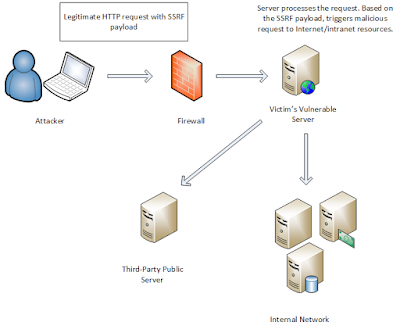SSRF (Server Side Request Forgery)
Server
Side Request Forgery (SSRF) refers to an attack where the attacker
can abuse functionality on the server to read or update internal
resources. The attacker can supply or a modify a URL which the code
running on the server will read or submit data to, and by carefully
selecting the URLs, the attacker may be able to read server
configuration such as AWS metadata, connect to internal services like
http enabled databases or perform post requests towards internal
services which are not intended to be exposed.SSRF is usually used to
target internal systems behind firewalls that are normally
inaccessible to an attacker from the external network. Additionally,
it’s also possible for an attacker to leverage SSRF to access
services from the same server that is listening on the loopback
interface (127.0.0.1).
Typically
Server Side Request Forgery (SSRF) occurs when a web application is
making a request, where an attacker has full or partial control of
the request that is being sent. A common example is when an attacker
can control all or part of the URL to which the web application makes
a request to some third-party service.
The
target application may have functionality for importing data from a
URL, publishing data to a URL or otherwise reading data from a URL
that can be tampered with. The attacker modifies the calls to this
functionality by supplying a completely different URL or by
manipulating how URLs are built (path traversal etc.).
When
the manipulated request goes to the server, the server-side code
picks up the manipulated URL and tries to read data to the
manipulated URL. By selecting target URLs the attacker may be able to
read data from services that are not directly exposed on the
internet:
-
Cloud server meta-data - Cloud services such as AWS provide a REST interface where important configuration and sometimes even authentication keys can be extracted
-
Database HTTP interfaces - NoSQL database such as MongoDB provide REST interfaces on HTTP ports. If the database is expected to only be available to internally, authentication may be disabled and the attacker can extract data
-
Internal REST interfaces
-
Files - The attacker may be able to read files using file:// URIs
The
attacker may also use this functionality to import untrusted data
into code that expects to only read data from trusted sources, and as
such circumvent input validation.
Mitigating Server Side Request Forgery (SSRF)
Whitelists and DNS resolution
Implementing
simple blacklists or regular expressions directly on the user’s
input to filter out which IP addresses or domains can make requests
is a bad
approach to take when mitigating an SSRF.
In
general, blacklists are a poor security control because there will
always be bypasses not envisaged by a developer. In this case, bypass
by an attacker are as easy as using an HTTP redirect, a wildcard DNS
service such as xip.io or even alternate IP encoding.
Instead,
the most robust way of dealing with Server Side Request Forgery
(SSRF) is to whitelist the DNS name or IP address which your
application needs access to. If a whitelist approach does not suit
your use case, and you must
rely on a blacklist, it’s important to validate user input
properly. An example of this is to not allow requests to private
(“non-routable”) IP addresses (detailed in RFC
1918), however, in the case of a blacklist, the correct
mitigation to adopt will vary from application to application. In
other words, there is no universal “fix” to SSRF since it highly
depends on the application’s functionality and business
requirements.
Response handling
Ensuring
that the response received by the remote server is indeed what the
server is expecting is important to prevent any unforeseen response
data leaking to the attacker. Above all else, under no circumstances
should the raw response body from the request sent by the server be
delivered to the client.
Disable unused URL schemas
If
your application only makes use of HTTP or HTTPS to make requests,
only allow those URL schemas. Disabling unused URL schemas will
prevent a web application from making requests using potentially
dangerous URL schemas such as
file:///,
dict://,
ftp://
and gopher://.Authentication on internal services
Services
such as Memcached, Redis, Elasticsearch and MongoDB do not require
authentication by default. Server Side Request Forgery
vulnerabilities could provide an attacker with the opportunity to
access some of these services without any authentication standing in
the way. Therefore, it’s best to enable authentication wherever
possible as another defense mechanism.




Comments
Post a Comment